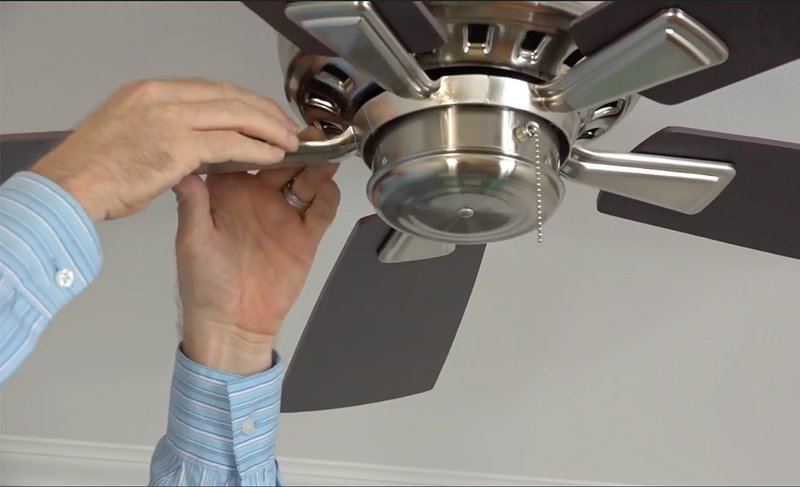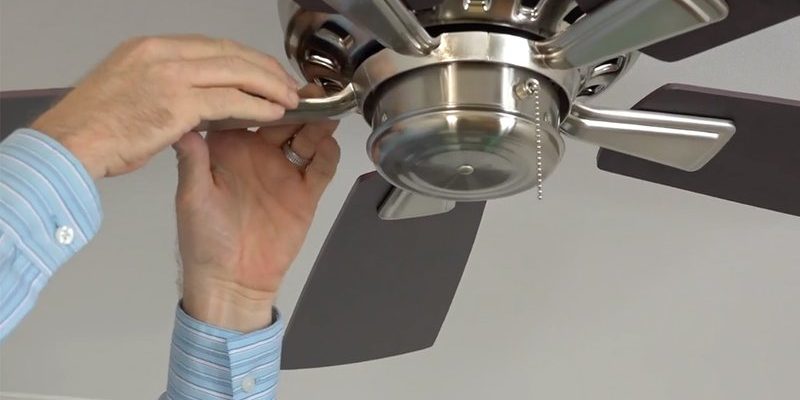
Hampton Bay ceiling fans are popular because they’re reliable and come packed with convenient features, like remote controls that let you adjust the fan speed and lighting from the couch. But when that dimmer function acts up, it feels like your living room has its own mind. I’ve helped friends work through these exact headaches, and I’ve seen how little quirks—like syncing issues, dead batteries, or remote code mix-ups—can throw the whole system off. Let me walk you through the most common problems and fixes, so your fan and lights go back to listening to you, not the other way around.
How Hampton Bay Ceiling Fan Dimmers Work
First, let’s demystify what’s happening behind the scenes when you hit the dimmer button. Hampton Bay remotes control the fan and light with radio frequency signals, kind of like how a garage door opener works. The dimmer specifically manipulates how much current gets to your light bulbs, letting you pick a cozy glow or full-bright mode.
It’s a slick system—until something interrupts the communication. If you’re using LED bulbs, things get even trickier, because not all LEDs play nicely with older dimmer circuits. Here’s the thing: most Hampton Bay remotes are designed for incandescent bulbs, and that mismatch can lead to buzzing, flickering, or the dimmer not working at all.
Inside the fan canopy, there’s a receiver that “listens” for your remote’s instructions. If the remote and receiver lose sync or get out of phase, your commands might not reach their target. It’s a little like shouting across a noisy room—the message just doesn’t land. Knowing this structure makes troubleshooting less intimidating and makes every fix feel more logical.
Common Reasons Your Dimmer Isn’t Working
Dimmer issues on a Hampton Bay remote almost always boil down to a handful of usual suspects. Start with the simplest possibilities first—trust me, it saves time and frustration.
- Dead or Weak Batteries: If the remote feels sluggish or only works up-close, swap in fresh batteries. Sounds obvious, but you wouldn’t believe how many dimmer “failures” are actually just tired batteries.
- Non-Dimmable Bulbs: If you’ve recently switched to LED or CFL bulbs, double-check the box for “dimmable.” Non-dimmable bulbs either won’t respond at all or could even damage the dimmer circuitry over time.
- Receiver or Remote Code Issues: Sometimes, the remote and receiver drift out of sync, especially after a battery change or power outage. When they can’t “talk,” the dimmer controls stop working, too.
- Electrical Interference: Other wireless gadgets, thick walls, or even nearby Wi-Fi routers can mess with the remote’s signal. If the dimmer works sporadically, interference could be the villain.
I once spent an hour troubleshooting before realizing my neighbor’s ceiling fan remote was on the same code as mine—every time he turned off his fan, my lights dimmed! Lesson learned: double-check your code settings and be aware of what’s happening around you.
Step-By-Step: Troubleshooting Your Hampton Bay Dimmer Remote
Let’s roll up our sleeves. Here’s a straightforward process to track down (and hopefully fix) your dimmer issues:
- Test the Batteries: Open the remote’s battery compartment. Pop in new batteries, making sure they’re installed the right way.
- Check the Light Bulbs: Remove your current bulbs. Replace them with dimmable LEDs or incandescents you know work. Don’t mix bulb types—use one kind per socket for accurate troubleshooting.
- Reset the Remote and Receiver: Turn power off at the breaker, wait about 30 seconds, then turn it back on. On the remote, hold down the “fan off” and “light” buttons together for up to 30 seconds. This will often reset the syncing code between the remote and receiver.
- Pair the Remote: Sometimes, you’ll need to re-pair (or sync) the remote. Flip open the battery compartment and set the DIP switches (tiny sliding switches) to match any code on the receiver, which is usually found inside the fan housing. Mismatched codes? The remote and receiver will ignore each other—kind of like siblings on a road trip.
- Test for Interference: Turn off other wireless devices nearby. Try operating the remote closer to the fan, away from obvious radio sources (routers, microwaves, etc.). If the dimmer begins responding, you’ve found your culprit.
You don’t need special tools for most of this. A step stool, screwdriver, and patience are your best friends during ceiling fan troubleshooting.
Understanding DIP Switch Codes and Sync Problems
Here’s where things can get a little technical, but stick with me—once you grasp the basics, it’s not so intimidating. Hampton Bay remotes and their matching receivers use something called DIP switch codes to communicate securely. These are tiny switches you slide up or down to form a unique pattern, kind of like a password. If those codes don’t match on both the remote and the receiver, nothing works—not the fan, not the light, not the dimmer.
You might be wondering, “Why do I need to mess with codes at all?” Well, if a neighbor has the same remote or you replace batteries and lose sync, your system needs to know who it’s supposed to listen to. Setting the DIP switches ensures your remote talks to your fan only.
If you’ve never opened up your fan—or if the idea makes you nervous—here’s how to find and set those codes:
- Unplug or turn off power at the breaker for safety.
- Remove the glass globe and light bulbs from the fan.
- Unscrew the canopy where the fan connects to the ceiling. Inside, you’ll spot a small black or white receiver box.
- On the receiver, you’ll see a row of 4 tiny switches. Set these to match the pattern inside your remote’s battery compartment.
The tiniest mismatch will throw everything off. Set each switch carefully, and make sure both ends match exactly.
Once you’ve matched up the codes, pop everything back together and test the dimmer. If it still won’t work, at least you’ve ruled out one major variable.
Replacing Batteries in a Hampton Bay Ceiling Fan Remote
You’d be amazed how many dimmer headaches come down to weak batteries. If your remote’s commands are delayed, spotty, or only work close to the fan, the batteries are usually to blame. Hampton Bay remotes typically use either AA or AAA batteries, depending on the model. Some older models take a 12V “A23” battery—a size you might not have lying around.
Here’s a quick way to replace them:
- Locate the battery compartment—usually a sliding or snapping panel on the back of the remote.
- Remove the old batteries and check for signs of corrosion or leakage. Sticky or crusty contacts? Clean them gently with a cotton swab dipped in rubbing alcohol.
- Insert new batteries, matching the + and – ends.
- Snap the compartment shut and try your dimmer again.
If the remote still acts up, try holding it a little closer to the fan. Sometimes, a remote that’s “on its way out” will work up close but not across the room—a clear sign it’s time for a replacement.
What To Do If Your Hampton Bay Remote Dimmer Only Works Partly
Maybe your lights dim, but not as much as you want. Or maybe the lowest setting still seems bright, or the dimmer works for one bulb but not another. Frustrating, right? Much of this comes down to bulb compatibility.
LEDs and dimmers share a complicated relationship. Older Hampton Bay dimmers are designed for traditional incandescent bulbs, which fade down smoothly. Most LEDs need a specific type of dimmer-compatible circuitry. If your lights flicker, cut out, or never dim all the way, it’s probably a mismatch.
You might be wondering, “Can I just buy any old dimmable LED?” Not exactly—look for LEDs labeled “compatible with all dimmers” or, better yet, check the manufacturer’s recommended brands. Swapping bulbs often solves partial-dimming issues instantly. If you have a mix of bulb types, replace them all at once for best results.
Honestly, most of the time, I see problems where one or two non-dimmable LEDs sneak into the mix. Consistency is key.
If everything checks out and the dimmer still only works partly, your fan’s receiver might be older and less compatible with modern bulbs. Upgrading the receiver to a newer, LED-friendly model is often the best fix.
When to Reset or Replace Your Hampton Bay Ceiling Fan Remote
Sometimes, no matter how much you fiddle with batteries, codes, or bulbs, the dimmer won’t cooperate. Here’s when you know it’s time to reset—or retire—your remote:
- You’ve replaced batteries, matched codes, tested bulbs, and tried syncing, but nothing changes.
- The dimmer works erratically, only at certain times, or not at all.
- There’s visible damage to the remote (cracked case, sticky buttons, corrosion inside the battery compartment).
Resetting is simple: remove batteries, turn off power at the breaker, wait a minute, then restore power and pop the batteries back in. This “soft reset” often clears minor glitches. But if the remote still fails to respond—or if you suspect the receiver inside the fan is fried—you may need to replace one or both parts.
Universal remotes can work in a pinch, but for full dimmer functionality, stick with official Hampton Bay replacement remotes or receivers. In rare cases, replacing the entire receiver inside the fan is necessary to restore smooth dimming.
Alternatives and Upgrades: Universal vs Original Remotes
If you’re fed up with troubleshooting, it might be tempting to grab a universal ceiling fan remote. These work with many brands, including Hampton Bay, but the dimming function isn’t always perfect. Some universal remotes only handle on/off or basic fan speeds—no dimming or fine adjustment.
Original Hampton Bay remotes are built to match your fan’s internal receiver, making them the safest bet for smooth dimming and full feature control. If you want to upgrade, look for “universal” kits that specifically mention dimmer compatibility and match your receiver’s voltage.
I’ve seen folks try smartphone-based smart switches or wall-mounted remotes as a workaround. While these can be convenient, they usually require swapping out the receiver inside your fan and rewiring—a bigger project, but one that opens the door to app control and smart home integration.
Final Thoughts: Getting Your Hampton Bay Ceiling Fan Dimmer Back on Track
Honestly, most ceiling fan dimmer issues come down to a few simple fixes—fresh batteries, proper bulb selection, matching receiver codes, or a quick reset. The whole system is like a conversation between remote and fan; if the “language” gets scrambled, nothing works quite right.
Take it step by step: check your batteries, test dimmable bulbs, confirm those tiny DIP switch codes, and don’t hesitate to reset the connection when things go squirrelly. With a bit of patience, your Hampton Bay remote can get back to dimming your lights exactly the way you want—no drama, no guesswork, just cozy lighting right at your fingertips. If all else fails, consider an upgrade or replacement that matches your needs. Your living room’s mood lighting is worth the effort.
